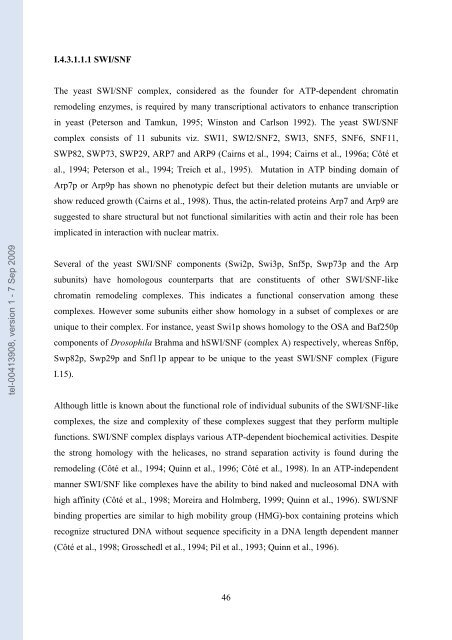Etudes sur le mécanisme de remodelage des nucléosomes par ...
Etudes sur le mécanisme de remodelage des nucléosomes par ...
Etudes sur le mécanisme de remodelage des nucléosomes par ...
Create successful ePaper yourself
Turn your PDF publications into a flip-book with our unique Google optimized e-Paper software.
tel-00413908, version 1 - 7 Sep 2009<br />
I.4.3.1.1.1 SWI/SNF<br />
The yeast SWI/SNF comp<strong>le</strong>x, consi<strong>de</strong>red as the foun<strong>de</strong>r for ATP-<strong>de</strong>pen<strong>de</strong>nt chromatin<br />
remo<strong>de</strong>ling enzymes, is required by many transcriptional activators to enhance transcription<br />
in yeast (Peterson and Tamkun, 1995; Winston and Carlson 1992). The yeast SWI/SNF<br />
comp<strong>le</strong>x consists of 11 subunits viz. SWI1, SWI2/SNF2, SWI3, SNF5, SNF6, SNF11,<br />
SWP82, SWP73, SWP29, ARP7 and ARP9 (Cairns et al., 1994; Cairns et al., 1996a; Côté et<br />
al., 1994; Peterson et al., 1994; Treich et al., 1995). Mutation in ATP binding domain of<br />
Arp7p or Arp9p has shown no phenotypic <strong>de</strong>fect but their <strong>de</strong><strong>le</strong>tion mutants are unviab<strong>le</strong> or<br />
show reduced growth (Cairns et al., 1998). Thus, the actin-related proteins Arp7 and Arp9 are<br />
suggested to share structural but not functional similarities with actin and their ro<strong>le</strong> has been<br />
implicated in interaction with nuc<strong>le</strong>ar matrix.<br />
Several of the yeast SWI/SNF components (Swi2p, Swi3p, Snf5p, Swp73p and the Arp<br />
subunits) have homologous counter<strong>par</strong>ts that are constituents of other SWI/SNF-like<br />
chromatin remo<strong>de</strong>ling comp<strong>le</strong>xes. This indicates a functional conservation among these<br />
comp<strong>le</strong>xes. However some subunits either show homology in a subset of comp<strong>le</strong>xes or are<br />
unique to their comp<strong>le</strong>x. For instance, yeast Swi1p shows homology to the OSA and Baf250p<br />
components of Drosophila Brahma and hSWI/SNF (comp<strong>le</strong>x A) respectively, whereas Snf6p,<br />
Swp82p, Swp29p and Snf11p appear to be unique to the yeast SWI/SNF comp<strong>le</strong>x (Figure<br />
I.15).<br />
Although litt<strong>le</strong> is known about the functional ro<strong>le</strong> of individual subunits of the SWI/SNF-like<br />
comp<strong>le</strong>xes, the size and comp<strong>le</strong>xity of these comp<strong>le</strong>xes suggest that they perform multip<strong>le</strong><br />
functions. SWI/SNF comp<strong>le</strong>x displays various ATP-<strong>de</strong>pen<strong>de</strong>nt biochemical activities. Despite<br />
the strong homology with the helicases, no strand se<strong>par</strong>ation activity is found during the<br />
remo<strong>de</strong>ling (Côté et al., 1994; Quinn et al., 1996; Côté et al., 1998). In an ATP-in<strong>de</strong>pen<strong>de</strong>nt<br />
manner SWI/SNF like comp<strong>le</strong>xes have the ability to bind naked and nuc<strong>le</strong>osomal DNA with<br />
high affinity (Côté et al., 1998; Moreira and Holmberg, 1999; Quinn et al., 1996). SWI/SNF<br />
binding properties are similar to high mobility group (HMG)-box containing proteins which<br />
recognize structured DNA without sequence specificity in a DNA <strong>le</strong>ngth <strong>de</strong>pen<strong>de</strong>nt manner<br />
(Côté et al., 1998; Grosschedl et al., 1994; Pil et al., 1993; Quinn et al., 1996).<br />
46

















